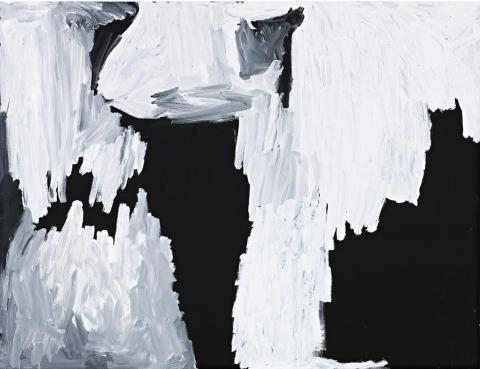DIBIRDIBI COUNTRY, 2012
MIRDIDINGKINGATHI JUWARNDA SALLY GABORI
synthetic polymer paint on linen
151.0 x 197.0 cm
bears inscription verso: artist’s name, title, medium and Mornington Island Arts and Crafts cat. 7669-L-SG-0412
Mornington Island Arts and Crafts, Queensland
Tim Melville Gallery, Auckland, New Zealand
Private collection, Sydney
Sally Gabori, Dibirdibi Country, Tim Melville Gallery, Auckland, 30 October – 24 November 2012
Dibirdibi Country, 2011, synthetic polymer paint on linen, 151.0 x 198.0 cm, The Harriet and Richard England Collection, illus. in Mirdidingkingathi Juwarnda Sally Gabori: dulka warngiid: Land of All, Queensland Art Gallery / Gallery of Modern Art, Brisbane, 2016, cat. 28, p. 106
Dibirdibi Country, 2012, synthetic polymer paint on linen, four panels, 121.0 x 484.0 cm, in the collection of Queensland Art Gallery, Brisbane, illus. in Mirdidingkingathi Juwarnda Sally Gabori: dulka warngiid: Land of All, Queensland Art Gallery / Gallery of Modern Art, Brisbane, 2016, cat. 34, pp. 104 – 105
Born by a creek in one of Australia’s most isolated areas, Mirdidingkingathi Juwarnda Sally Gabori grew up on Bentinck Island in Northern Queensland, part of the Kaiadilt people who used marine resources to fulfil all their needs and had very little outside contact. An intense drought followed by a tidal surge made the island uninhabitable, and at the age of 24 Mirdidingkingathi (meaning born at Mirdidingki River) Juwarnda (her totem, the dolphin) Sally Gabori and her family were persuaded to move to Mornington Island – a move that prompted feelings of huge loss for the Kaiadilt people. Gabori began her art career late in life, at the age of 85, and Judith Ryan of the National Gallery of Victoria compares her immense innovation and star power to that of similar late-starters, Emily Kame Kngwarreye and Lorna Fencer Napurrula.1 However, unlike many other Aboriginal language groups, the Kaiadilt did not have a tradition of mark making, whether on tools, objects or bark. Taking this cultural background into consideration, Gabori’s style is completely self-made, conjured from maps in her mind of Bentick Island and the country she loved.
Dibirdibi Country, 2012 depicts one of her favourite subjects – the land and the story inherited from her husband. Painted later in her life when her deteriorating stamina and health required a modification of her painting style, here she experimented with opaque layers that would dry completely, before using thinner paint to create the lighter, pearlescent brushstrokes, reminiscent of shimmering water.
Gabori is known primarily for her brightly coloured canvases, with monochrome works such as this being less common. The restrained colour palette does nothing to dampen the vitality of the work however, each intuitive and gestural brushstroke being boldly executed. When Gabori paints Dibirdibi, the meanings layer in multitudes – she is at once painting the saltpans of the land, the Rock Cod Ancestor Dreaming of Dibirdibi Country, a portrait of her late husband in connection to his country, and finally – her own longing, loss and memory.
1. Ryan, J., ‘Broken Colour and Unbounded Space’, Mirdidingkingathi Juwarnda Sally Gabori: dulka warngiid: Land of All, Queensland Art Gallery / Gallery of Modern Art, Brisbane, 2016, pp. 33 – 34
LOUISE CHOI
